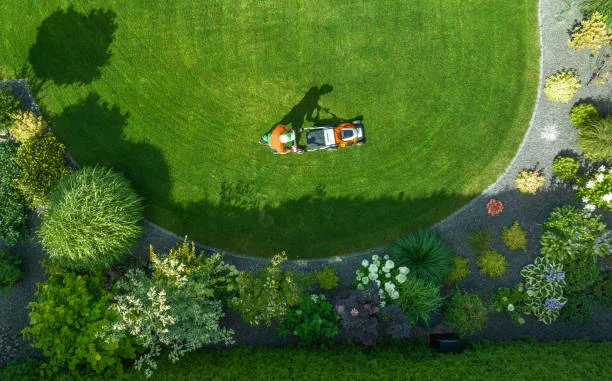What makes a lawn thrive while another just struggles to survive year after year? The answer lies in understanding the science happening beneath the surface and within the grass itself.
Lawns are living systems influenced by soil biology, nutrient cycles, climate, and seasonal rhythms. When you know why certain tasks matter at different times of the year, every step (from watering to fertilizing) becomes more effective. Caring for a yard is no longer guesswork, it’s about working with the natural processes that keep grass healthy all year long.
Curious about this topic? Discover more insights in our related post!
The Living System Beneath the Grass
A healthy lawn starts with healthy soil, and soil is much more than just dirt. It’s a living ecosystem filled with microorganisms, organic matter, and minerals that directly influence how grass grows.
Bacteria and fungi in the soil break down organic material into nutrients that grass roots can actually absorb, while earthworms and insects help improve structure and aeration. Without this hidden life, grass has little chance of staying strong throughout the year.
Soil chemistry also plays a critical role. The balance of nitrogen, phosphorus, and potassium (N-P-K) determines whether your grass can grow, repair itself, and resist stress. Soil pH controls how easily these nutrients are available to plants. Too acidic or too alkaline and grass won’t get what it needs even if the nutrients are present.
Temperature also matters. When soils are cold, nutrient uptake slows dramatically, which is why feeding your lawn at the right time of year makes such a difference.
Spring – Awakening and Root Establishment
In spring, soil temperature is the real signal that tells grass it’s time to grow, not the air temperature. Once the ground consistently warms, roots wake up and begin expanding.
This is why aeration and dethatching are so effective in spring. They reduce compaction and allow oxygen, water, and nutrients to reach the root zone just as the lawn is actively rebuilding. Giving grass this kind of access early helps it develop the deep root systems that will carry it through the stresses of summer.
Fertilization in spring works best when timed to this root activity. Early spring nitrogen promotes leafy growth, but the real value is in supporting root energy and density.
Grass with a strong underground foundation is less likely to thin out or allow weeds to take hold. Spring is also when many cool-season weeds germinate, so a dense root and shoot system is your lawn’s best natural defense against them.
Summer – Stress and Survival
Summer is the toughest season for lawns because heat, drought, and pests all put grass under stress. During hot days, photosynthesis slows down and grass shifts into energy conservation mode. This is why it may look less vibrant even if you’re caring for it properly.
The best way to help during this time is through watering practices. Deep, infrequent watering encourages roots to grow downward, while shallow watering keeps them near the surface, making the lawn more vulnerable to drought and heat. If you’re unsure about the right watering schedule for your lawn type, you can always visit the Grass Store for guidance and supplies tailored to seasonal challenges.
Mowing also plays a surprisingly scientific role. Cutting grass higher in the summer provides shade to the soil, reducing water loss and keeping root zones cooler.
Taller blades also mean deeper roots, which improves resilience to both pests and fungal diseases that thrive in warm, humid conditions. While it may seem counterintuitive, less frequent mowing at a higher setting actually helps the lawn endure summer’s challenges.
Fall – Preparation and Energy Storage
Fall is the season when grass shifts its energy from growing upward to strengthening its root systems. Even though blades may not look as active, photosynthesis is still happening, and the sugars produced are stored in the roots to fuel growth in the spring.
This is why fall fertilization is often considered the most important of the year. Feeding the lawn at this stage helps build up carbohydrate reserves that support both winter survival and early spring growth.
It’s also the best time for overseeding, especially in cool-season lawns. Adding new seed fills in bare patches and creates a denser turf that reduces weed pressure in the coming year.
Soil is still warm enough for seeds to germinate quickly, and seasonal rains often provide ideal moisture. Fall is also the right time to add lime or compost if soil tests show imbalances, giving amendments time to work before dormancy sets in.
Winter – Dormancy, Rest, and Protection
In winter, lawns often look lifeless, but the grass is far from dead. Most species enter dormancy, slowing metabolic processes to conserve energy. Roots remain alive under the soil, drawing on stored nutrients from fall.
Protecting this dormant state is important because stress during winter (like compaction from heavy foot traffic) can weaken the grass and delay its recovery in spring. Snow can act as insulation, but it also comes with risks.
Repeated freeze-thaw cycles can heave soil and damage roots, while ice cover may suffocate grass if it lingers too long. Mulching leaves or applying light protective layers can help insulate soil in areas without reliable snow. The specific challenges differ by region. Northern lawns must endure frozen ground, while southern lawns often remain semi-active and require lighter, but still attentive, care.
Common Misconceptions and Mistakes
One of the biggest misconceptions about lawn care is that more water is always better. In reality, overwatering can suffocate roots by limiting oxygen and create ideal conditions for fungal disease.
Grass benefits far more from occasional deep watering than from frequent, shallow sessions. Another common mistake is assuming that grass needs constant fertilization. Too much fertilizer can cause rapid, weak growth and increase the risk of nutrient runoff into waterways.
Cutting grass too short is another widespread error, often made in late fall or early winter. This practice, called scalping, exposes crowns and roots to cold injury and reduces the lawn’s ability to photosynthesize when it resumes growth.
Understanding the science behind these mistakes shows that the best approach is often moderation. Watering deeply but less often, fertilizing strategically rather than constantly, and mowing at the right height for the season.
Conclusion
Can a lawn really be both low-maintenance and high-performing? The key is aligning care with the science of how grass grows and responds to its environment.
Soil biology, nutrient timing, water management, and seasonal changes all shape the strength and resilience of your lawn. By applying these principles, the effort you put in pays off with healthier roots, greener blades, and fewer long-term problems. A well-maintained yard isn’t just visually appealing, it also supports cleaner air, cooler surroundings, and a more sustainable outdoor space.
Don’t miss our spotlight content—see why this post is getting all the attention!







